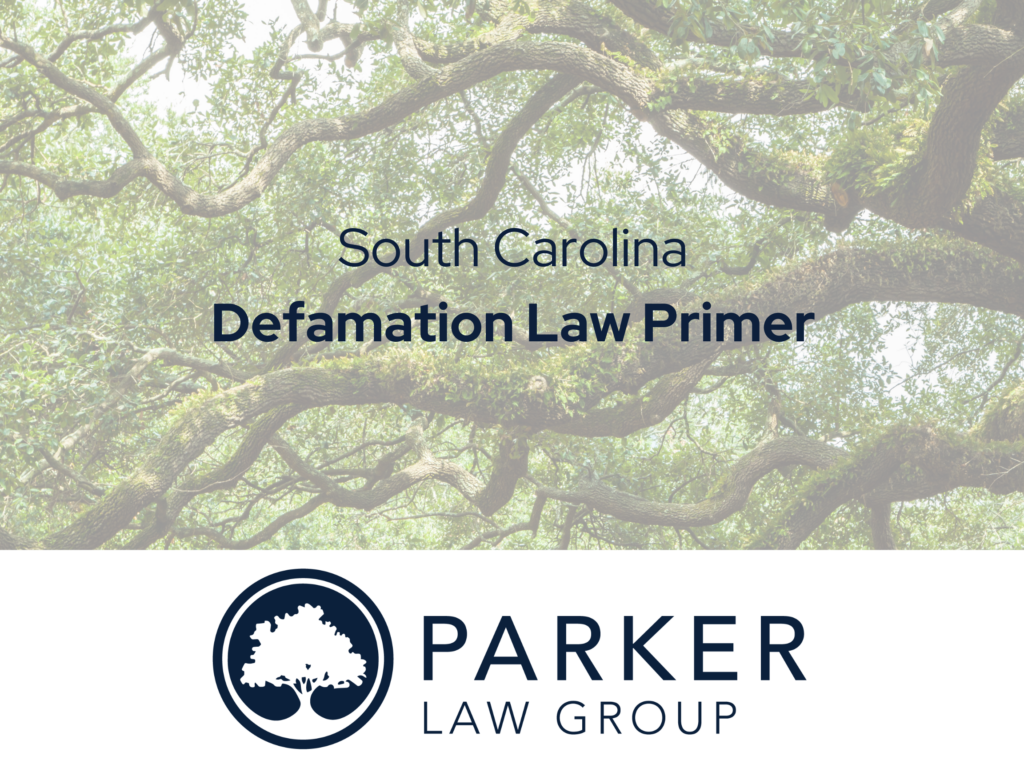South Carolina Defamation Law Primer

“Reputation is like fine china: Once broken it’s very hard to repair.”
– Abraham Lincoln
I. Overview.
The tort of defamation permits a plaintiff to make a civil claim against a defendant to recover damages resulting from the defendant’s communication to others of a false message about the plaintiff, and includes written communications (libel) as well as spoken defamation (slander). The severe repercussions of defamatory statements have been recognized by South Carolina since its inception, and it is criminal in South Carolina to publish false statements about another person.1 Under South Carolina law, the elements of the defamation claim are as follows: (1) a false and defamatory statement concerning another; (2) an unprivileged publication to a third party; (3) fault on the part of the publisher; and (4) either actionability of the statement irrespective of special harm or the existence of special harm caused by the publication.2Defamation claims could include false statements made by a local newspaper about a town official, false television reports accusing private citizens of immoral conduct, or a neighbor spreading false gossip about other neighbors on social media apps such as Nextdoor.
Based on the tort’s four elements of proof, one would be led to believe that a defamation action is fairly straightforward, but in the words of Justice Toal, “there is a great deal of the law of defamation which makes no sense”, and certain areas of South Carolina defamation law are “mind-numbingly incoherent.”3 When compounded with issues of insurance policy exclusions and sovereign immunity under the South Carolina Tort Claims Act, even the seemingly mundane task of drafting allegations for a complaint can become a trap for the inexperienced practitioner. Your choice of language in drafting a complaint can become a sword that is used against you later by an insurer, or by the State, to exclude coverage or dismiss your tort claim under statutory exceptions to the State’s waiver of immunity.
II. Plaintiff’s status and its effect on common law and constitutional law claims.
When considering the merits of a potential client’s case, you will need to analyze whether your client is a private individual, a limited public figure, a public figure, or a public official, and whether the defamatory statements were about a matter of public concern or private concern.4This could drastically affect your burden of proof on several of the elements of the claim. Whether or not the publisher is a media defendant will also play a part in the amount and quality of evidence you will need to survive a motion for summary judgment or to obtain a successful verdict at trial.
For example, when the defamation is published by a non-media defendant concerning a private figure and private matters, certain presumptions are afforded by the common law if the statements are deemed to be actionable per se.5 Such presumptions include a presumption that the statements are false, a presumption that the statements were made with fault, and a presumption that the plaintiff was damaged.6 For all practical purposes, this transforms the tort into something akin to a strict liability claim for the plaintiff, and requires the defendant to come forward with proof on these elements in an affirmative defense. A defendant who fails to do so will practically concede liability to the plaintiff. Such private figure claims, which are exclusively governed by state common law, present far fewer difficulties than a public figure claim involving the media, which will invoke the Constitution’s First Amendment protections of the defendant’s speech.
When a defamatory statement is published about a public figure by a media defendant, the plaintiff must prove fault under the constitutional actual malice standard with clear and convincing evidence, which generally speaking makes it one of the more difficult claims to successfully litigate in civil court.7 Whether a claim involves a private figure, public figure, or media defendant also implicates additional requirements in order to claim punitive damages.8 It should be obvious that a defamation claim can rise and fall on how your client is classified by a court. The distinction between the classifications is not as clear as it may seem, and South Carolina and federal case law have provided for some overlap and grey area between the classifications, depending on the client’s occupation and status. Thoughtful arguments informed by experience and a working knowledge of the case law can be useful in convincing a court to grant your client a more favorable classification and an easier pathway to the courtroom.
III. Damages (and recent developments) in South Carolina defamation law.
The damages encompassed by a defamation claim include wounded feelings, mental distress, and injury to reputation, as well as special damage that your client may have experienced due to a loss of business or other forms of economic harm. It should be patently obvious from the articulated elements of the defamation claim that a plaintiff has historically never been required to prove injury to reputation through direct evidence. This is unsurprising because from a practical standpoint, it is nearly impossible to have a smoking gun witness come forward and admit that, based on a false statement made about the plaintiff’s character, the witness thought ill of a plaintiff whom they previously knew. This is compounded by the fact that any change of opinion would have likely been made without any regards to the truth or falsity of the statement, something a witness would be extremely hesitant to admit.
This common sense approach to the historical framework of a defamation claim has been called into question recently by the Supreme Court of South Carolina, and in a recent decision the Court seemingly articulated a new hurdle for the defamation claim, requiring private figure plaintiffs in cases involving media defendants to prove injury to reputation, to the exclusion of other forms of general damage, through direct testimonial evidence.9 In other words, proof that a false and defamatory statement was published by a media defendant to the public, accompanied by direct evidence of emotional harm, may no longer be sufficient evidence of damage to a plaintiff’s reputation, even if the statement is actionable per se. While the decision at the time of this writing is subject to rehearing, it seems likely that in the near future it will be even more difficult to prove First Amendment defamation claims against media defendants, and that the plaintiffs’ bar will have to be even more creative in developing proof of harm to clients’ reputations through discovery mechanisms and available evidence.
IV. Affirmative defenses.
Numerous affirmative defenses are available to both private and State defendants in defamation actions. For example, there is a common law qualified privilege that exists to protect communications between individuals with a common interest, such as within a business, when those communications are made without malice and in furtherance of the individual’s shared interest.10 An absolute privilege protects statements made in connection with judicial and legislative proceedings, from the State to municipal levels of government.11 Media defendants have several defenses available, including the fair report privilege.12 Other affirmative defenses unique to the defamation context include opinion and truth. However, just because a statement is couched in terms of an opinion does not make it protected speech, and even a speaker’s “opinions” may be actionable depending upon the circumstances.13
V. The Tort Claims Act and its actual malice exception.
As previously mentioned, cases arising under the Tort Claims Act present challenges when strategizing and litigating a defamation claim against the State. For example, the Tort Claims Act contains an exception to its waiver of liability for conduct that constitutes actual malice or an intent to harm.14 Defense attorneys will use this exception in an attempt to dismiss defamation claims against the State, arguing that defamation is an intentional tort and in a defamation action a plaintiff must prove malice as an element of fault, ergo his claims are precluded by sovereign immunity under the Act. By careful pleading and development of testimony in discovery, a plaintiff can avoid this trap, as all defamation claims do not necessarily require evidence of intent to harm or actual malice in order to be viable.
VI. Insurers will commence actions to frustrate your client’s recovery.
Numerous issues may arise even if the plaintiff obtains a successful verdict against the State, a private business, or a private individual. While most insurance policies on their face purport to provide personal injury protection for defamation, they almost always include numerous exclusions that attempt to obviate coverage for defamation under numerous contexts. The manner in which the allegations of the underlying defamation action were pled, as well as the evidence developed and arguments made at trial and in hearings, can be used by attorneys for the insurer to argue in a subsequent declaratory judgment action against coverage that would satisfy your client’s judgment. It is vital to be aware of the language of these exclusions and to be cognizant of them when examining witnesses and formulating arguments.
VII. Summary.
In sum, despite their deceptive simplicity, defamation claims are extremely nuanced and require care and thoughtful litigation strategy. Due to the nature of the damages, the outcome of a defamation claim can be hard to predict and can present challenges when it comes to evaluating your client’s case. Our law firm has extensive experience with litigating defamation claims and can assist you and your clients with navigating these complexities. Regardless of the challenges and difficulties, defamation claims are extremely rewarding and worth taking on regardless of their monetary value, as you will be assisting the client with winning back their reputation and peace of mind.
“Good name in man and woman, dear my lord,
Is the immediate jewel of their souls:
Who steals my purse steals trash;
‘Tis something, nothing;
‘Twas mine, ‘tis his, and has been slave to thousands;
But he that filches from me my good name
Robs me of that which not enriches him,
And makes me poor indeed.”
-William Shakespeare, Othello, act III, scene 3.
Footnotes
[1] S.C. Code Ann. § 16-7-150.
[2] Holtzscheiter v. Thomson Newspapers, Inc., 332 S.C. 502, 506 S.E.2d 497 (1998).
[3] Id.
[4] A thorough discussion of the classifications of a plaintiff under defamation law may be found in Erickson v. Jones St. Publishers, LLC, 368 S.C. 444, 629 S.E.2d 653 (2006).
[5] All libel is considered actionable per se, and certain categories of slanderous statements can also be classified as actionable per se. Holtzscheiter, 332 S.C. at 509-510, 506 S.E.2d at 501-02.
[6] Erickson, 368 S.C. at 465-66, 629 S.E.2d at 664-65.
[7] New York Times Co. v. Sullivan, 376 U.S. 254, 84 S. Ct. 710, 11 L.Ed.2d 686 (1964).
[8] Erickson, 368 S.C. at 466-67, 629 S.E.2d at 665.
[9] Garrard v. Charleston Cnty. Sch. Dist., Op. No. 28155 (S.C. Sup. Ct. filed May 31, 2023).
[10] Harris v. Tietex Int. Ltd., 417 S.C. 533, 790 S.E.2d 411 (Ct. App. 2016).
[11] Crowell v. Herring, 301 S.C. 424, 392 S.E.2d 464 (Ct. App. 1990).
[12] West v. Morehead, 396 S.C. 1, 720 S.E.2d 495 (Ct. App. 2011).
[13] Milkovich v. Lorain Journal Co., 497 U.S.1, 110 S. Ct. 2695, 111 L.Ed.2d 1 (1990).
[14] S.C. Code Ann. § 15-78-60(17).

